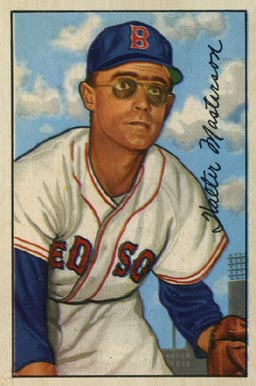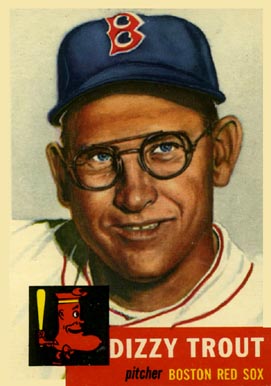Hard to believe, but eyeglasses were the steroids of their era. Before the '20s, no self-respecting ballplayer would wear them, and they were often referred to as “cheaters.” “Specs” Toporcer is usually recognized as the first major leaguer to wear them, followed closely by Hall of Famer Chick Hafey.
Thirty years later, in the golden age of baseball and baseball cards, eyeglasses were much more accepted. Not exactly fashion statements … but there were players willing to pose for their baseball cards with “cheaters” firmly ensconced.
Ah yes, fashion … It changes. What might look incredibly hip and cool one year may well look dorky and lame a couple of years later. But, heck, ballplayers aren’t exactly known as fashion plates to begin with, are they?
So, here they are … Fashion statements from the 50s, fashion mis-statements, and fashion non-statements.
I think I know this guy ... I’ll bet you didn’t know this Hall of Fame manager was also something of a playuh. Yup, eight seasons, four teams, 25 home runs, lifetime OPS of .529 … Well, maybe not much of a playuh …
I’ll bet you also didn’t know his real name was Dorrel Norman Elvert Herzog either. Makes “Whitey” sound real good, doesn’t it? Of course, his other nickname – “The White Rat” – beats ‘em all.
Even without the glasses, Dick Hyde doesn’t look much like of a ballplayer. I have a hard time imagining him as “Moose,” or “Hawk,” or “Bull” (though I might buy “The White Rat”).
It’s the glasses that really make this one though. I don’t think I’ve ever seen anything quite like these before. Okay, you’ve got your basic John Lennons. But then you add this weird supporting piece. Is that how they made “sports glasses” back in the 1950s? Scary.
Dick was a stockbroker after retiring. What a surprise! Those glasses have “stockbroker” written all over them.
Jim’s got the same glasses as Dick, but with a very different look. Actually, if his hair were just a little longer, this card wouldn’t look that out of place in the ‘70s. Somehow, those specs look just so much cooler on Jim.
Jim Baxes had some major stick-to-itiveness. He spent 12 years in the minors before breaking in with the Dodgers at age 30. That was his only year in the majors though. It was back to Portland
Hey, I know this guy. Didn’t he win the gold medal for crossed-eyed guys, 1950s division?
Somehow, Bowman has managed to give Tom a totally different look this time, but still make him look really weird. Poor guy.
Hey, it’s the same guy! No, wait a minute. This one looks a little thinner. And Tom’s eyes are no way near that buggy. I wouldn’t be surprised if these two weren’t related somehow though.
Walt Masterson had a pretty good career, including starting the All Star game in ‘48. The definite highlight for me, though, had to be his going 16 shutout innings against the White Sox in ’47. Can you imagine asking a modern starter to do that?
And here's one of Walt sans specs.
And here's one of Walt sans specs.
Hmm … Same vague family resemblance. Maybe all Don here needs is a little tint to his glasses and a little time in the sun.
What I particularly like about this one, though, is the utter incompetence with which poor Don’s glasses are rendered. I know these particular cards (Bowman ‘51) started out as paintings, but glasses … just … don’t … look … like ... that.
Don Richmond made it to the bigs four times between the years ’41 and ’51. As you can imagine, that was basically just four cups of coffee. He only got 34 at bats lifetime.
Dizzy? Are you sure it wasn’t Goofy?
Paul Howard Trout was classified 4-F during WWII because of hearing loss. That allowed him to dominate the AL
He also tried a comeback in ’57, at age 42. That didn’t go so well (81.00 ERA kind of says it all).
After that, Dizzy announced Tiger games for a couple of years, as well as hosting a sports show for kids. He was well-loved for his “self-effacing humor, scrambled syntax, and folksy demeanor” (at least according to Wikipedia). Dizzy? Yes. Goofy? Definitely.
More dizziness right ici.
* - author has this card
Wanna see what glasses looked like in the '60s? Click here. '70s? Right this way.
More dizziness right ici.
* - author has this card
Wanna see what glasses looked like in the '60s? Click here. '70s? Right this way.







No comments:
Post a Comment